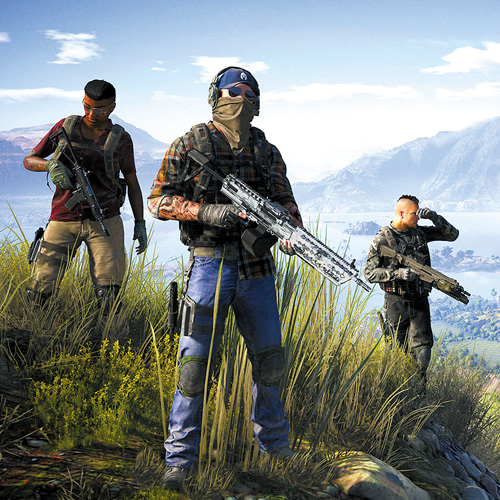Ubisoft embraces excess for its latest Tom Clancy shooter

“Ghost Recon Wildlands”
Platform: PlayStation 4, Xbox One, PC
Style: 1-Player Shooter (4-Player Online)
Publisher: Ubisoft
Developer: Ubisoft Paris
Rating: M, for Mature
By Matt Bertz | Game Informer Magazine
Tom Clancy’s fictional special-forces operation is no stranger to adaptability. Over the course of the franchise’s 15-year history, the interventionist Ghosts have stymied Russian ultranationalists, destabilized the North Korean army, and squelched a Mexican insurgency. For its latest major operation, Ubisoft throws a squad of fresh faces into the massive open world of Bolivia, tasking them with systematically dismantling the Mexican drug cartel that has turned the peaceful South American country into a cocaine-crazed narco-state.
After the U.S. embassy is bombed in the Bolivian capital and the resident DEA agent is kidnapped, the U.S. deploys a covert unit to disrupt the cartel’s operations and take down the charismatic and powerful leader, El Sueño. You (and up to three friends) must gather intelligence to identify cartel members and team up with local rebels to carry out discrete missions that undermine its black market business. This is no overnight operation. With the cartel spread throughout 21 regions of the biggest open world I’ve seen in a shooter, expect to be here a while.
Once you identify a faction head of a region, disrupting the target’s operation becomes the primary objective. Each boss serves a different role in the organization, which affords “Wildlands” a diverse array of missions. During my 50-plus hours, I kidnapped a famous narco-corrido, destroyed submarines carrying cocaine to the United States and Europe, played cartel members against one another, and burned cocaine warehouses worth billions of dollars. The thematic diversity helps mask the fact that a large degree of missions essentially boils down to clearing or infiltrating bases of various sizes.
Whether you are raiding a small base for new weapon parts or playing a story mission, “Ghost Recon Wildlands” shares many basic traits with its predecessors. The tactical combat rewards carefully planning your approach, making the drone your best friend. Identifying enemy positions, alarms, and mission targets opens a variety of strategic options for experimentation. This is where cooperative play shines.
With four players working in concert, you have so many possibilities at your disposal. Perhaps one Ghost drives into the base with a Santa Blanca vehicle, buying him or her enough cover to sneak past the front guard to disable the radar jammer and capture the target while the other players systematically eliminate the snipers perched in towers and guide him through the maze of enemies on the ground. Perhaps two Ghosts create a diversion, drawing enemies away from the warehouse you need to destroy while another Ghost skydives in with the C4.
The tactical creativity “Wildlands” enables is its biggest strength, but don’t expect your plans to always succeed. The roaming Unidad forces may attack the cartel, rebels, or Ghosts at any given moment, making improvisation critical to surviving the messy skirmishes. You never know when Unidad is going to disrupt your covert attempts, and all hell breaks loose when they join the fray. I appreciated how this x-factor makes you think on your toes, but I came to hate how frequently they appeared out of nowhere.
“Wildlands” is clearly designed for cooperative play, but you can also dismantle the cartel solo. Given the limitations of your control of A.I. companions, you can’t split your team up to employ more complicated strategies, but if you upgrade the sync shot ability, they serve as a great tool for thinning the enemy herd before you go in guns blazing. They stay out of trouble for the most part and come to your rescue if you take one too many bullets.
The biggest enemy in “Wildlands” isn’t the cartel or Unidad, it’s repetition. Each region breaks down into a handful of story missions and a checklist of weapons to gather, skill points to find, lore documents to reveal, and rebel side missions to complete to bolster their ability to support your efforts. By the tenth region or so, the process feels rote. I wish Ubisoft Paris better differentiated the tasks you need to complete in each region instead of giving you a cookie cutter to-do for each one.
Repetition creeps into story missions as well thanks to some rookie design mistakes. Many multi-part missions lack checkpoints, forcing you to complete the entire job from scratch if your plans go awry. Ubisoft Paris even replays cutscenes at the beginning of these missions, forcing you to skip ahead. Given the time it takes to complete Wildlands, the only antidote to the feeling of déjà vu is the creative approach you bring to the experience.
Repetitive gameplay loops aside, the cooperative tactical variety and vast open world make “Ghost Recon Wildlands” a singular experience unlike any other shooter on the market. “Wildlands” may not succeed with all its ambitions, but it’s a compelling direction for the series that points to a fertile future.











